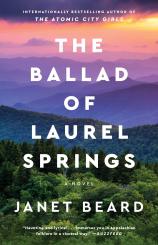The Ballad of Laurel Springs
Review
The Ballad of Laurel Springs
Janet Beard’s THE BALLAD OF LAUREL SPRINGS begins in the present and gives us context for the ballads that are repeated throughout each woman's tale. The novel runs for over a century, told about and by women, all of whom are related by blood or circumstance. Each woman shares her story --- some taking place in a year, some over many years --- in a first-person narrative. At times, it almost feels like they are speaking directly to us. Pearl's first sentence is "I don't believe in witches.... Seems to me folks just like to blame their troubles on someone. If your cow stops giving milk, it's probably sick, and if your horse up and dies, it's probably gotten old. It's not a witch's fault --- just bad luck." That attitude changes horrifically later in her story.
During the difficult times after Pearl's sister, Polly, is killed, she feels sorry for Polly's best friend, Violet. Violet becomes the schoolteacher in the one-room schoolhouse that Pearl's children attend. Two women come from Atlanta and are set on building a real school in Tates Valley for the students. They want to help the people in this part of Appalachia, teach them crafts and hygiene, and give the youngsters a proper education. But when Pearl spies on Violet in a secluded place and sees her in a passionate embrace with one of the women from Atlanta, she decides that Violet is not a good person. And when Pearl's last baby dies during childbirth with one of the ladies from Atlanta attending and Violet taking the baby right after the birth, she concludes that Violet is a witch.
"Each woman shares her story --- some taking place in a year, some over many years --- in a first-person narrative. At times, it almost feels like they are speaking directly to us."
Pearl tells us about venturing to Knoxville for the first time for her daughter's wedding and being overwhelmed by the buildings and the bustle. She goes to a department store to buy a new hat when she sees Violet at the register. Violet gives her a small smile that Pearl decides is a witch-smile, and she leaves without buying the hat. Pearl misses Tates Valley: "I know everyone there, and I know how things work. I don't know what you've heard, but it's a good place. Folks may not have much, but they look out for one another. That's how it's always been." But later, in another twist, we learn through her son's eyes that her kind, loving husband is really a monster.
Each woman's story is connected to other stories by strands that we sometimes miss as they are almost buried in the narrative. It's later that we read a passage and think, "Wasn't there something about that before?" Some connections are more apparent. We know that Miriam, who married Pearl's son Jake, grew up in a lovely house in Douglasville. She continued to live there for years when Jake disappeared after the war. He was presumed dead until he reappeared after his father's death. Miriam's father was a prominent lawyer, and the house was distinguished by beautiful carved wood trim.
We don't really think about that until later, when Frieda is narrating and she recounts a conversation with her father about the carpenter who did that --- Silas King, her grandfather. Jake tells Frieda, "There weren't a finer carpenter in all of Tennessee. Everone knew it…. Silas King was respected in Douglasville, but things were differnt up here in Tates Valley. Folks couldn't afford fancy carpentry, and they resented a colored man making good money from his skill." And he relates a story that explains why he disappeared for eight years, essentially because of his hatred for his father and what he stood for.
The stories are also connected by the old ballads, the "murder ballads," as they are called. They mostly end with a woman getting killed by a man she loves. While the ballads have been passed down through generations, it's purely coincidence that one of them features Polly and her killer, Willie. Yet that theme, violence related to romance, runs through this generational story. And while there is misogyny --- cleverly one of the women, Carrie, wrote an essay titled "The Same Old Song: Misogyny in Traditional Murder Ballads and Contemporary Horror Films" --- we also see woman-on-woman hate and lives being destroyed as a result. A woman who ventures into the Appalachian Mountains to "better" the folks there collects old ballads. She comments, "Americans have made a habit of memorializing young girls' murders in songs that are a dime a dozen. 'Omie Wise,' 'Pearl Bryan,' your 'Pretty Polly.'"
Any woman who didn't comply with the norm --- married young with children --- was often suspected of being a witch. Like a master puppeteer, Beard also manipulates some strings that appear again and again. The original Will Reid, who killed Polly, escaped but was imprisoned when he murdered his wife later. His son, Charlie, was sent back to Tates Valley and raised by relatives as one of their own sons. He and his progeny are involved in the lives of the women we meet. Beard does not prettify these women. They lie about being raped, and in one case it leads to the execution of a wrongly accused man, and they have relationships that end with the death of the male lover. In fact, she shows us women who are at the center of the violence as they allow it to happen or act in a manner that causes the violence.
And the ballads are sung throughout, the ones about Pretty Polly and others. In some ways, music and the lilt of the fiddle tie this story to the traditional ballads that have shaped a huge part of our American history. Often, they are based on real events; sometimes, in a cruel twist, real events mirror a ballad already in existence.
Reviewed by Pamela Kramer on October 23, 2021
The Ballad of Laurel Springs
- Publication Date: July 25, 2023
- Genres: Fiction, Women's Fiction
- Paperback: 288 pages
- Publisher: Gallery Books
- ISBN-10: 1982151579
- ISBN-13: 9781982151577




